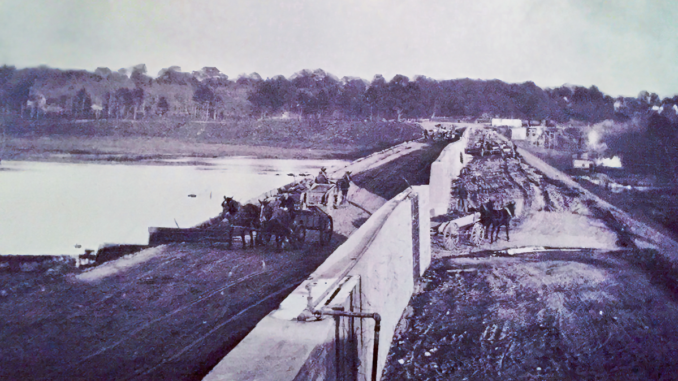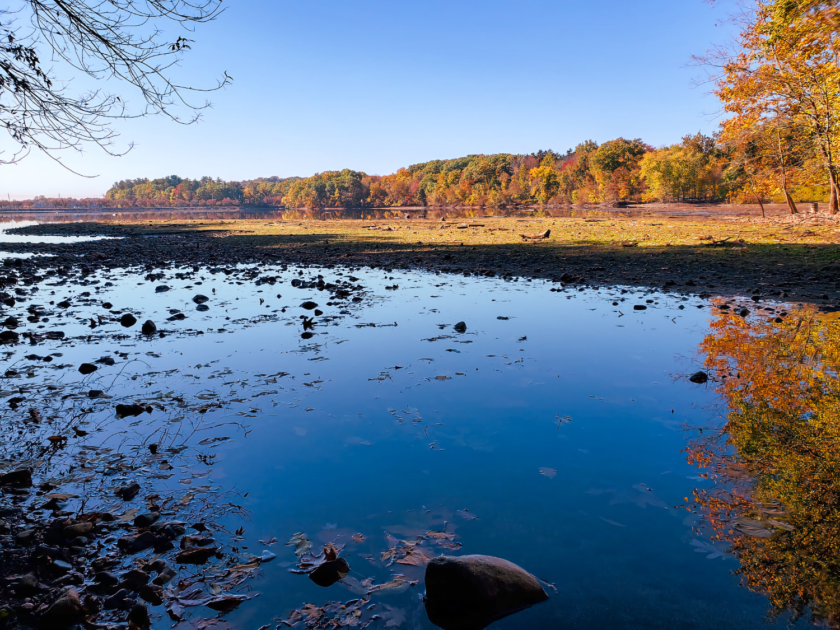
WOODCLIFF LAKE—It is difficult to imagine our Pascack Valley landscape without Woodcliff Reservoir. Yet this enormous body of water, with a capacity of 871 million gallons, did not always exist. It is not a natural lake but rather was created by Hackensack Water Co. at the start of the 20th century.
From summer 1903, hundreds of laborers, mostly Italians, put their shovels in the ground and transformed an expanse of farmland, meadow, and orchard into a water storage reservoir. The Pascack Brook already flowed through the land, parallel to the railroad. This new project created a dam on the brook to contain a drinking water supply for an ever-growing population.
Like all big changes, the construction of the reservoir brought its share of controversy. In order to make its project a reality, the water company needed to buy up acreage from the farmers of Woodcliff—and they were in no big hurry to give up their land. The local people worried about the risk of malaria from having a large pool of water in the middle of their town, as well as the potential for flooding.

In the end, the decision came down to politics. Republican Mayor Samuel B. Reed, who was opposed to the reservoir, was being succeeded by Democrat John Ackerman, who was in favor of its construction. Ackerman helped the Hackensack Water Company secure the land it needed.
In response, the opposition formed the Citizens Association headed by Reed. Many believed that Woodcliff was not receiving fair compensation from the water company, which would make millions of dollars selling the water.
Just as the population was divided, so, too, was the governing body. A vote on whether to proceed with the reservoir’s construction resulted in a 3–3 deadlock among council members. It was up to Mayor Ackerman to cast the tie-breaking vote. Of course, he voted in favor of a reservoir.
The county’s largest newspaper at the time, the Hackensack Republican, wasn’t shy about voicing its stance in its Feb. 2, 1904 edition: “When the reservoir is built and the stagnant water converts Woodcliff into a summer resort with malaria as its leading allurement, every citizen will make a bequest to place a wreath of roses upon the grave of Mayor Ackerman.”
Construction ran 1903–1905, during which the population of Woodcliff, normally home to just 400 people, doubled as the water company brought in its workforce. The laborers consisted mostly of newly arrived Italian immigrants. The work was hard: in that era before heavy machinery, the men used hand shovels and horse-drawn wagons to move earth, and they did this in all kinds of weather. At night they slept in crudely built wooden shanties that the water company had built.
And, unfortunately, they faced a lot of prejudice. While an Italian-American influence is ubiquitous in today’s Pascack Valley, the region’s population before the 20th century had historically been Dutch with an assortment of other northern and central European ethnicities. An influx of Catholic Italians at the beginning of the 1900s was met with some disdain, and the Pascack Valley of 120 years ago was wary of the workforce the water company had brought in.
One article from April 1904 reported that as the water company’s 400 Italian laborers would roam the village of Hillsdale when not at work, the Township Council appointed constables to keep an eye on them. Reports chastised the workers for being too loud, contaminating the water supply when they washed their clothes, and “committing other nuisances.”
In December 1904, Hillsdale’s constable spotted an Italian walking with a rabbit he had shot. The officer chased the man, who ducked into one of the shacks near the reservoir. Inside there were about 40 “of the same tribe of foreigners,” the constable reported. Because all Italians looked alike to him, he was unable to pick the man out.
With the completion of the reservoir, the water company’s itinerant workforce moved on in spring 1905. Their hard work created a reservoir that is still integral to our water supply 120 years later, and which presents some of the most beautiful scenery in the Pascack Valley. This body of water so transformed the landscape that in 1910 the name of the borough was changed from Woodcliff to Woodcliff Lake.
— Kristin Beuscher is president of Pascack Historical Society
